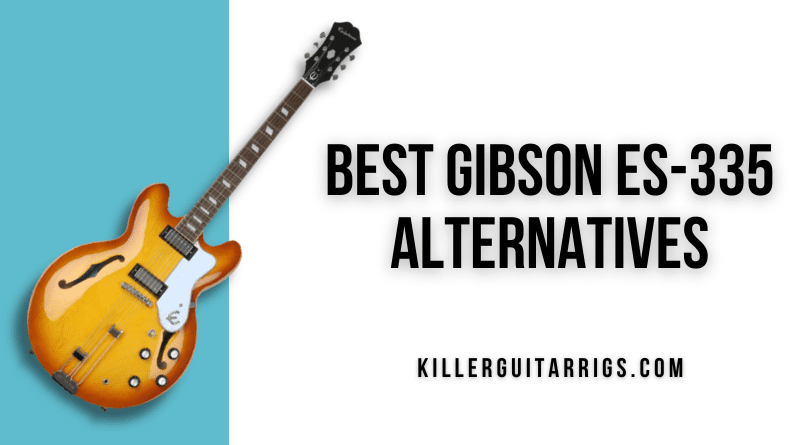The Gibson ES-335 is without a doubt the quintessential semi-hollow guitar. Its biggest problem? The price. Even on the used market, these Gibsons hold their value like nothing else. Brand new, you’re looking at a minimum of $3,000.
Being able to spend $3,000 or more on a single guitar puts a player in some rarified company, but as with any popular guitar design, there are tons of tributes, and even some licensed copies of the original ES-335 on the market.
If you’d love a Gibson ES-335, but perhaps can’t quite manage the lofty price tag, we’ve prepared a roundup of the 7 Best Alternatives available today in this KillerGuitarRigs Review. They all share similar styling with the Gibson, and we evaluated each against the same metrics – price, build quality, playability, and tone.
Anyone wanting to know which is the best Gibson ES-335 alternative should definitely keep on reading.
Read more about our review process.
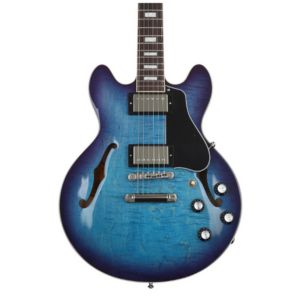
Gibson ES-339
Features: Highly figured top, '57 Classic Humbuckers, Nitro laquer finish
Benefits: Outstanding build quality, Incredible tonal variety, Pro level playability
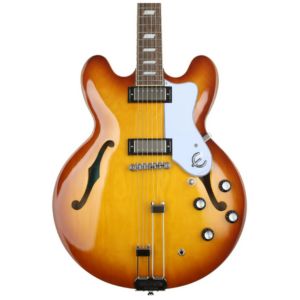
Epiphone Riviera
Features: Dual Pro Mini humbuckers, CTS pots, Grover tuners
Benefits: Solid tuning stability, Classic semi hollow tones, fantastic vintage looks
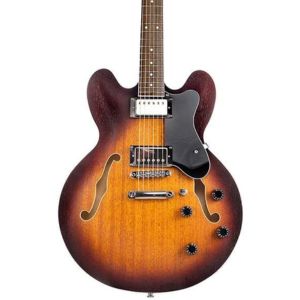
Eart E-335
Features: Compound radius, Stainless steel frets, Mahogany body
Benefits: Rich tones, Exceptional fretwork, Great playability
Contents
Our Top 3
Our Top Pick in this roundup was the Epiphone Riviera. The Riviera was Epiphone’s take on the ES-335 before the Gibson Merger, and as such was always a logical alternative. It’s beautifully-made, and perfectly blends price and performance.
If you’re trying to get a great ES-335 alternative without spending too much, our Best Value choice, the Eart E-355 is almost a cult classic. It’s very heavily inspired by the Gibson original, and offers some of the best fretwork you’ll find on any guitar in this price range.
In the event you’re working with a bigger budget and are looking for something just a little different than a Gibson ES-335, check out our Editor’s Choice, the Gibson ES-33. It offers the exact kind of high-end performance you’re after.
Individual Reviews
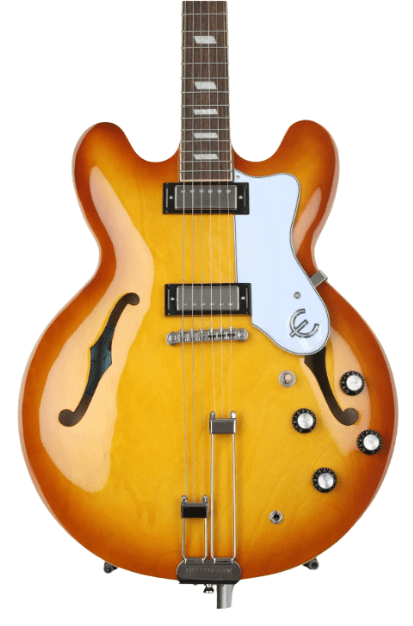
Epiphone Riviera
The original alternative to the Gibson ES-335.
This is a truly wonderful alternative to the ES-335. It offers some unique design cues that distinguish it from replicas and copies, and at the same time, sticks to the same formula that has made the Gibson such a success for so many decades. It gets high end hardware, fantastic build quality, and timeless styling.
The Epiphone Riviera was launched in 1958 and is a direct competitor to the ES-335, which was coincidentally launched that same year. It’s been a perpetual favorite of some of the world’s most influential guitarists, and for good reason.
It was made with a maple top, back and sides, and came to us in a stunning “Royal Tan” finish, which is quite similar to a honey sunburst. It had traditional F holes adorning the top, providing superb projection and a classic look.
As you’d expect from a guitar of this style, it came with a set mahogany neck. Unusual for a modern Epiphone, it had a rounded C profile, which is a departure from the SlimTaper D found on most of their models. It was chunkier than we’re used to from Epiphones, but it really nailed the vintage feel. The fretboard was Indian laurel, and it came bound with parallelogram inlay and excellent fretwork.
The pickups were Epiphone PRO mini humbuckers, and they were some of the coolest we’ve heard on any Epi. The neck pickup was razor sharp without ever coming across harsh and with the tone rolled back, it was super sweet. In the middle position, the Riviera is much brighter than the ES-335, as is the bridge pickup. By working the volume and tone knobs, we got some great sounds from this guitar – it was truly very versatile.
The hardware also helped it to stand out on its own. It had a Frequensator tailpiece, which significantly extends the 3 bass-side strings, giving them much less tension and slightly increased sustain. It had Epiphone Deluxe-style tuners which performed exceptionally, and the Tune-o-matic bridge delivered superb intonation.
Verdict: The Epiphone Riviera is one of the classic semi-hollow designs, making a fantastic alternative to the ES-335. It has a style all its own, while still looking similar. And of course, it has a huge following among pros and amateurs alike. It offers superb vintage tone with modern playability, and best of all, it’s still affordable for most players.
- Extremely similar dimensions to the Gibson
- Awesome mini humbuckers
- Gorgeous finish
- Some may find the neck too thick
- Frequensator tailpiece is highly sylized

Eart E-355
One of the best playing semi hollow guitars under $1000.
This ES style guitar has become internet famous for its incredible fretwork and superb playability. Considering the low price, it offers excellent build quality and attention to detail, and it really nails the semi hollow tone made famous by the Gibson ES-335.
The Eart E-355 gained notoriety on YouTube with a slew of positive press from some high-profile vloggers. Since then, it’s been one of the most popular semi-hollow 335-style guitars on the market.
The body was all mahogany and had a classic Sunburst finish. The clear coat was a very thin matte type, allowing the grain of the wood to be properly seen and even felt. It wasn’t exactly luxurious, but it was still extremely well finished.
It had a roasted maple neck and a rosewood fretboard, both highly desirable woods in guitar-building. The neck was fairly slim and had a flattened D profile, which we found to be extremely comfortable and very forgiving, even during longer sessions.
The fretwork is one of the biggest selling points of this Eart. It came with stainless steel wire, polished to a mirror finish with perfect edges. Considering the price point, it was absolutely incredible, and really sets the bar for what can be accomplished with a budget instrument.
The electronics were quite basic, but still provided quality tones. It was warm, full, and very nicely balanced with good cleans, and still was able to get down and dirty when pushed hard. Surprisingly, it had full-size pots, which delivered a nice sweep with no noticeable dropoff, something that tends to plague cheaper guitars.
Tuning gear was all unbranded and quite plain, but regardless, it delivered rock-solid stability and easy fine-tuning. The rest of the hardware was all good quality, too, and didn’t have the cheap pot-metal feel that we so often find on non-mainstream brand instruments in this price range.
Verdict: The Eart E-355 delivered in every way we asked. It served up the classic ES-335 tones, offered incredible playability and comfort, and really looked great. The fretwork was insane, and almost justifies the purchase all on its own.
- Incredible value for money
- Stainless steel frets
- Great tones
- Little known brand
- Limited finish options
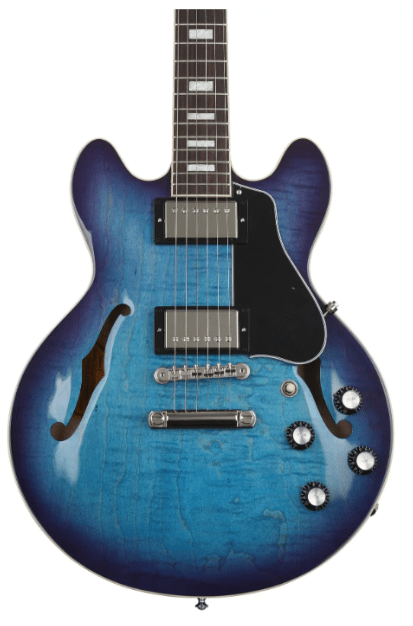
Gibson ES-339
A hard rocking icon designed to suit players of all genres.
If you’re looking for a high end flagship guitar, you really can’t go wrong with this Gibson. Like the ES-335, it’s a legend in its own right, with incredible looks, massive tone, and surprising versatility all coming in its stride. This is not a cheap guitar by any means, but it’s one that few would argue isn’t worth every penny.
The Gibson ES-339 is the guitar that immediately sprang to mind when we were thinking of high-end alternatives to the ES-335. It’s the ideal alternative for those who love the looks and tones of the ES-335, but who might be looking for something a little smaller.
We received a figured model in Blueberry Burst to test for this roundup and it was an immediate hit with the KGR crew. It’s very different-looking, and really helps to modernize what is a pretty classic style. As you’d expect, it had a lovely nitro finish and the paintwork was impeccable from every angle.
It featured a 3-ply maple and poplar laminate for the body construction, which kept the weight down while still providing the projection and brightness maple is famed for.
The neck was mahogany and felt simply fantastic. The rounded C profile was fast and comfortable, and the finish was incredible. We don’t always like to speak in superlatives, but Gibson really knocked this out of the park. We found the fretwork was superb, too. Like most modern Gibsons, it was PLEK’d, which left every fret feeling perfect.
As for electronics, it had a pair of ’57 Classic humbuckers, which are as close to true vintage PAF pickups as we’ve found on any guitar. They gave us lovely warm cleans and got raucous when we pushed hard on an overdriven MESA/Boogie Rectifier model on our Katana Head.
We found that the hardware was great across the board, with Grover Rotomatic tuners, a GraphTech nut, and a high-end tune-o-matic bridge all working in harmony to serve up perfect intonation and rock-solid tuning stability.
Verdict: The Gibson ES-339 is truly the king of ES-335 alternatives. It’s as close as you’re going to get without actually buying one. It has a slightly smaller body size, which results in (in our opinion) improved playability over the 335, but without sacrificing any tone or sustain. It looks amazing, and if you’re looking for the very best – this is it right here.
- Same quality as the Gibson ES-339
- Comfortable small body
- PLEKd frets
- Expensive
- Often sold out
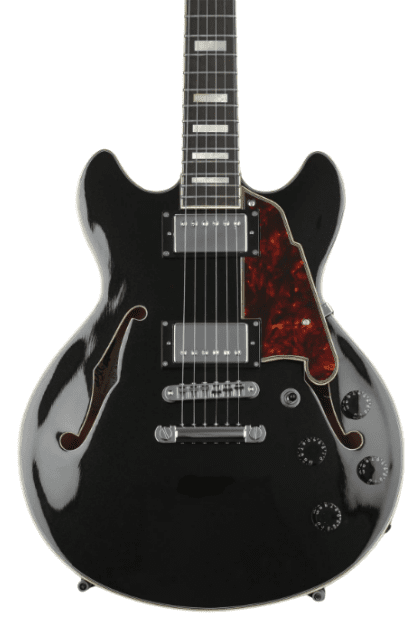
D'Angelico Premier Mini DC
An Art-Deco take on the classic ES style silhouette.
If you value aesthetics as much as tone, you’ll love this model. Taking inspiration from New York’s art deco movement, it blends art and function in a way that few other guitars can manage. It also helps that it’s a beautifully made guitar, and even comes with a nice gig bag.
The D’Angelico Premier Mini DC is their entry-level semi-hollow model. While it has styling all of its own, it’s obvious that the Gibson ES-335 was a big inspiration.
We got the chance to test a very sleek-looking “Black Flake”-finished example, which had a deep luster and really sparkled when it caught the light. Of course, glittery guitars aren’t for everybody, but we very much enjoyed it.
The body was made with laminated spruce, which really contributed to the acoustic performance and sustain. It had a C profile maple neck, which delivered bright and snappy performance. Topping off the neck was an ovangkol fretboard, which was the most disappointing part of the guitar for us. Instead of looking deep and dark, it looked quite grey and washed out.
The fretwork was, on the other hand, thankfully very well done. The edges were well-finished and the crowns were properly leveled and nicely polished.
We found that the pickups were the most outstanding feature of this guitar. It was loaded with a pair of Seymour Duncan-designed humbuckers. They had a vintage style with great clarity and still managed to deliver some heavy-hitting rock tones. They were quite similar in tone to the ’57 classics on the 339, but weren’t quite as composed when playing with the tone rolled back.
Another awesome feature on the Premier Mini DC was the hardware. It came with custom Grover Rotomatics with the stairstep “art deco”-style keys. They really added to the look, and being Grovers, they performed exceedingly well.
Verdict: The D’Angelico Premier Mini DC was tons of fun to play. We enjoyed putting it through its paces across different genres and, had it not been for the dull fretboard, it would have been in contention for top pick. Despite that, it’s still a great performer, and if you’re willing to put the work in to refresh the wood, this is going to be a great choice as an ES-335 alternative.
- Classic styling
- All spruce body
- Custom Grover tuners
- Pickups prone to losing composure
- Washed out fretboard
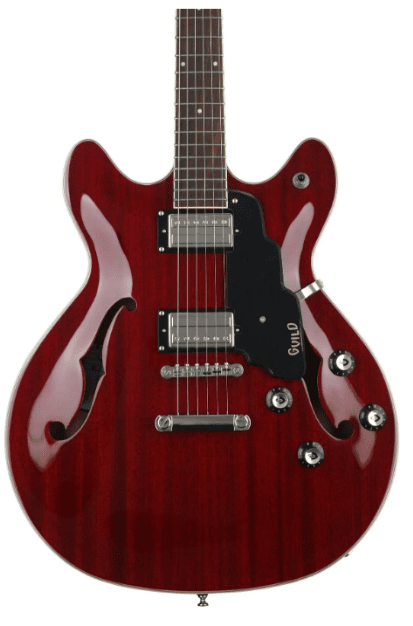
Guild Starfire I DC
A great looking and light weight guitar with classic tones.
With this fantastic Guild semi hollow guitar, you’re getting a very traditional instrument that still delivers a modern range of tones. It comes from a brand with a great history of making quality guitars, and it has a number of fantastic touches that really help it to stand out.
The Guild Starfire I DC is a classy-looking, double-cut semi-hollow with a gorgeous arch top and back. It’s an amazingly affordable model considering the specs, and certainly lives up to the brand pedigree.
The arched body was made from mahogany, which really lent itself well to the semi-hollow body style. It had an attractive grain that showed nicely through the translucent Cherry Red finish, and the off-white binding absolutely popped.
It had a vintage soft U profile on its mahogany neck, which honestly slowed down play a little. Vintage U shapes aren’t always the most forgiving, so if you’ve never played one before and thick necks aren’t your thing, perhaps check out something with a D or C profile instead.
We did love that it came with a nice Indian rosewood fretboard. It had a gorgeous, deep-brown color that nicely complemented the Cherry finish. The fretwork was another highlight for this Guild. Everything was in good order, with a decent polish on the crowns and well-finished edges.
Electronics-wise, the Starfire was something of a heavyweight performer. Its HB-2 Alnico humbuckers served up tons of PAF-style goodness, with a thick warmth and crazy sustain. They even had coil-splitting abilities, giving us the option to get some single-coil tones, which sounded super unique in this semi-hollow form factor.
The open gear tuners combined throwback looks with modern performance, and we absolutely loved them. They performed brilliantly, and just set off the whole aesthetic perfectly. We also loved the positioning of the pickup selector switch on the treble side horn. This kept it well out of the way during spirited play, so there were no accidental or unexpected tone changes.
Verdict: This Guild Starfire I DC had tons of potential, but we were ever-so-slightly let down by the neck. If it had a more neutral neck profile, it would have been a much better player. Having said that, if you’re a fan of thick necks, you’ll probably love it. It did deliver some superb tones and the construction quality was close to peerless at this price point.
- Excellent brand heritage
- Awesome open gear tuners
- PAF Style pickups
- Slow neck
- Single coil mode was too thin sounding

Ibanez Artcore AS73
Excellent value from one of the biggest names in the business.
Not only is this awesome Gibson ES-335 alternative an affordable choice, but it still offers a huge feature set, including premium materials, and some great pickups that deliver big on all the tones most players look for in this style of guitar.
The Ibanez Artcore AS73 is a big step up from their entry-level AS53 model, but it still retails at an incredibly-attainable price point.
This model comes in a range of unique finishes, with colors not often seen on this style of guitar. Our test model arrived in Olive Metallic, which we actually found to be more of a seafoam green than an olive hue, but it still looked great. The body was made with linden, which you might otherwise know as basswood, a great tonewood for warmth and pronounced mids.
If there’s one thing Ibanez does exceptionally well, it’s necks, and this nato neck was no different. It was very slim, making it comfortable for new players and fast for those with a bit of experience. It had a much nicer finish than the lower-end AS53, too. The walnut fretboard looked good and felt great under the fingers, and the frets had great edges. The slight downside was the crowns felt a little gritty, but of course this can be polished out.
The pickups performed well, serving up some wonderful bright cleans with just enough warmth to avoid any shrill tones while still remaining clear. With the tone rolled back, we got some great blues sounds and with the right amp settings, they growled nicely, handling everything from rock to metal with ease.
We found the hardware was all pretty solid. There were no issues with tuning stability, and the tuning machines themselves made fine-tuning a simple affair. The intonation was good, and even though it’s on the more affordable end of the scale, nothing about it felt cheap.
Verdict: If you’re looking for an afforable Gibson ES-335 alternative, and having a guitar from a well-known brand is important to you, the Ibanez Artcore AS73 has got to be one of the best options out there. It looks great, offers excellent playability, and has a really versatile range of tones that’s sure to keep any player happy.
- Great finish options
- Clear pickups
- Excellent tuning stability
- Frets felt gritty
- Relatively heavy
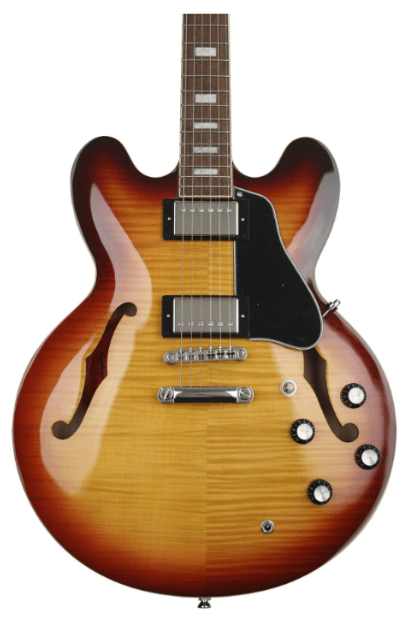
Epiphone ES-335
Stunning looks and authentic feel.
Sometimes the best ES-335 alternative is simply an ES-335. This Epiphone offers authentic looks and feel, with high end components, incredible aesthetics, and superb build quality.
The Epiphone ES-335 is about as close to a Gibson ES-335 as it comes for under $1000. After all, it is the only licensed replica on the market.
We got our hands on the Raspberry Tea Burst finish, which is one of the nicest finishes we’ve seen on any guitar recently. The figuring on the maple top was phenomenal and the burst transition was absolutely seamless.
Just like the Gibson, it had a layered-maple body, and a solid-maple center block, all combining to deliver tons of punch and the kind of resonance and sustain you’d expect from a quality semi-hollow guitar.
The neck had a rounded C profile and was made with mahogany. It was extremely comfortable, although being a gloss-finished neck, it was prone to a bit of stickiness from time to time. The laurel fretboard was nice, and the fretwork was well-finished, just as we’ve found with almost all recent model Epiphones.
It had Epiphone Alnico PRO humbucking pickups, which are effectively the full-size versions of those in the Riviera we tested. They gave us tons of variety in our tone, from crisp cleans to warm neck tones, plus snarling, angry lead tones from the bridge position. It had a diverse sound and we were thoroughly impressed.
As for hardware, it came with the Epiphone Deluxe Kluson style tuners. They performed admirably, holding firm and offering easy fine-tuning. The Tune-o-matic bridge was set perfectly and we found it had a lovely low-mid action and perfect intonation right out of the box.
Verdict: Had it not been for the sticky neck, the Epiphone ES-335 would likely have been our top pick. In all other areas, it makes a great alternative to the Gibson, especially if budgetary restraints are driving your decision. It offers extraordinary value for your money and comes highly recommended (check our full review here).
- Actual licensed copy of the Gibson
- Stunning finish
- Great setup from the factory
- Sticky gloss neck
- Slight muddiness from the neck pickup
How to Choose The Right Guitar For You
Whatever your reason for seeking an alternative to the Gibson ES-335, there are a few key points to consider when shopping for your guitar. If you’re not where to start, we’ve provided a handy guide below that covers everything you should be looking for.
Pickups
The majority of Gibson ES-335 alternatives will come with humbucking pickups, just like the original. They work extremely well with the semi-hollow design and deliver all the warmth and sustain these guitars are known for, and are also capable of handling high levels of overdrive and distortion.
Some alternatives come with coil-splitting pickups, too. This allows players to get both single-coil and humbucking tones from the same set of pickups, literally doubling the tonal variety.
Finally, some ES-style guitars come with P90 pickups. P90s are a single-coil design invented by Gibson that have drawn their own cult following on account of their ability to play both bright, clear tones, and easily rip it up with their snarling overdriven voice.
Construction Materials
The Gibson ES-335 is made with a laminated maple body and a mahogany neck. It’s been made this way since the ’50s, and has become the de facto construction method for this style of guitar. However, other manufacturers are starting to break away from this and use different woods in their guitars’ construction, including:
Maple
Maple is, of course, the classic ES-335 body (and center block) building material. It serves up bright tones and because it’s a very hard, strong wood, it holds up well to knocks. Perfect for a relatively delicate semi-hollow guitar.
Mahogany
When used as a body wood, mahogany delivers a warm, slightly dark tone that pairs brilliantly with humbucking pickups. Like maple, it’s a heavier wood, so an all-mahogany construction is unlikely to shave off any weight vs a Gibson ES-335.
Linden
Linden is otherwise known as basswood, and is a common tonewood used on Asian-made guitars due to its wide availability on the Asian subcontinent. It’s light in both color and weight and is a highly-affordable wood, making it popular for use in budget guitars.
Spruce
Spruce is more widely used in the manufacture of acoustic guitars, but when used for semi-hollows, you still get a similar bright, snappy response. It’s much lighter than maple, making spruce-bodied ES-335 alternatives a comfortable choice for those who prefer a lighter guitar.
Design
If you’re looking for something that looks like a Gibson ES-335, but isn’t actually a Gibson ES-335, here are the classic design cues you should be looking for:
- A double-cut body
- Mouse ear horns
- Standard F holes
- Centerblock construction
- Arch top and back
- Raised pickguard
Final Thoughts
The Gibson ES-335 is such an icon that suggesting alternatives often feels like a disservice. However, there are many reasons a player may want something different, and we think these 7 options covered in the roundup cover pretty much all of the bases. We reviewed guitars at all ends of the price scale, from a bunch of great brands.
In summary, our Top Pick went to the Epiphone Riviera due to its fantastic performance and attainable price. Our Best Value winner was the Eart E355, thanks in part to its surprisingly-premium appointments and great sonic performance. Finally, our Editor’s Choice went to what we think is the best alternative to the Gibson ES-335 at any price, and that’s the Gibson ES-339.

